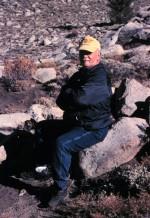Longtime Ecosystem Scientist and Friend of the LTER Network
Tom Callahan, for many years a leader in the promotion and support of long-term studies, died at his home on Friday, Sept. 10 after a prolonged illness.
Tom was many things: a devoted husband and father, a long-time Program Officer in the National Science Foundation, and certainly a mentor to hundreds of us in ecosystem studies in North America.
Tom was born in the mountains of Virginia, where his father worked for a coal mine before taking a more remunerative job at the Savannah River Plant (SRP) in Aiken, South Carolina.
Tom attended schools in Aiken, and then the University of South Carolina. He began a Master's degree with Dave Coleman, then switched over to his Ph.D. work, examining the population growth and regulation of the fall webworm, Hyphantria cunea Drury.
Dave first met Tom when he was an undergraduate at the Savannah River Ecology Laboratory in the summer of 1968, when he signed on with several others in an undergraduate research program funded by the U.S. Atomic Energy Commission. Tom showed early signs of being both a raconteur and polymath, and impressed the faculty in their daily sessions of Introductory Ecology, seminar style, in the sand-hills and wetlands country of the SRP.
In Tom's dissertation work, he carried out much of his population census research by observing the various instars on cherry and persimmon trees along many backroads of the SRP. Dave kidded him about getting a tanned left arm, cruising along in that old Ford Falcon pickup, but Tom's technique demonstrated the very linear and patchy nature of the insect distribution convincingly. He also was interested in what these creatures ate, and their impacts on nutrient cycling, which was published in a short paper he co-authored with Dave Coleman and Carl Monk in The Canadian Entomologist in 1969, based in part on some of his undergraduate research studies.
Tom spent most of his time for 1970-72 at UGA, completing course work, and getting active in Earth Day in April 1970. The word ecology did not have much meaning for the public until that first Earth Day -- and Tom helped bring it about.
Tom finished his degree work in Zoology with Dac Crossley in June 1972, as Dave Coleman had gone to a new job in the IBP Grassland Biome Lab in Fort Collins, Colorado in January of that year. As an ecologist, Tom hit the ground running; he became Ecosystem Studies Program Director at the NSF and many remember his first IBP coordinating committee meeting held in Alta, Utah, in October, 1972, where he was the bearer of sad tidings. Some of the budgets were to be cut back significantly in 1973, and Tom got a first-hand impression of how much senior scientists hate being told they are getting their funding cut.
Many have wondered if that first early experience is what made him so assiduous in his garnering of funds for Ecosystem Studies, especially in the early days of the LTER Program (which began formally in 1980, but was planned from 1977 onward).
In that era of flat funding for NSF (through much of the 1970s and 1980s), Tom found funds to keep his Ecosystem Studies budget growing at 2-3 percent above inflation, whcih was a major accomplishment. This was also a result of the influence of John Brooks, who was the Division Director for much of that period. Tom and John were very different individuals but they shared a common vision of making the LTER program better and "gently" guiding the scientists to develop broader programs and network the sites into an effort that remains unparalleled in the U.S. John listened to Tom, and vice versa, and this pair was primarily responsible for the LTER growth over much of two decades.
Tom's devotion to his "baby", the LTER, for which he, Frank Golley, Paul Risser, Jerry Franklin, and Wayne Swank were jointly responsible, is by now legendary. His seminal paper in BioScience in 1984, setting forth the rationale and long-term goals for this kind of research, is one of the classics of the early LTER era.
Tom attended or supervised literally hundreds of site reviews, mostly of LTER projects. He let the external reviewers handle much of the hour-by-hour reviewing tasks, but was more than ready to administer what he termed a "whup along the side of the head", when the occasion demanded. Those of us who served on panels he convened at NSF headquarters were always impressed at his erudition and grasp of the facts in the many proposals being covered, and more importantly, the science behind the proposals.
Tom was not one to beat around the bush. His comments, offered as a program officer, were always direct and for that reason they were welcome, even when they contained negative criticism. One of Tom's significant contributions to Ecosystem Science was that he provided the institutional memory for Ecosystem Studies at NSF and the patience of Job in training numerous rotators who served as Program Directors for Ecosystem Studies.
He was one of those rare people who had a truly photographic memory, the ability to recall, and the humor to use this gift wisely and in a mentoring fashion. Tom was that uncommon individual, combining wit, wisdom, and support for literally a generation of ecosystem ecologists, and more importantly, encouraging persons from other levels of resolution, namely population and community ecology, to come under the tent of LTER studies. For all this, he will be remembered as a true colleague and friend. We will not see his like again.


 Enlarge this image
Enlarge this image